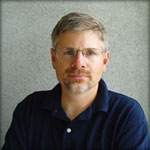Dying to Text
 "I never intended on it being more than just a couple of studies."
"I never intended on it being more than just a couple of studies."
University of Utah's Dr. David Strayer, professor of psychology, has gained such national prominence through his research in driver safety that nearly 10 years after his first published study, Driven to Distraction, he will appear in January on the "Oprah Winfrey Show."
Strayer studied aviation psychology as a grad student at the University of Illinois at Urbana-Champaign. His research focused on multi-tasking pilots, pilot distractions that ultimately lead to crashes and how to make planes safer. He was also part of designing a flight system for the military's Apache helicopter.
"My background was in aviation, looking at how pilots fly and what overloads them, so why not look at distracted driving as well," Strayer said.
After taking a job at the University, Strayer continually noticed drivers drinking coffee, talking on the phone and steering with their knees. That is when he asked himself, "How is this safe?"
A "couple of studies" turned into countless news articles, over a dozen scholarly publications and dual-task studies that simulated driving and conversing on a cell phone.
The virtual-reality driving simulator, used in Strayer's studies, is able to change road and weather conditions to replicate a specific driving environment and offers a 180 degree view of the road. Using an eye tracker, the simulator, equipped with a functioning horn, gas and brake pedal, is able to record where people are looking while they are driving and creates a digital record of everything that happens.
Strayer's research has led to many front-page stories in The New York Times, and the National Safety Council now has a Web site dedicated to distracted driving, which "aims to change this trend and prevent crashes, injuries and deaths."
During the September National Distracted Driving Summit, transportation officials addressed the dangers of distracted driving. The Summit led to an executive order signed by President Obama banning federal employees from text messaging while driving.
"I never expected this to be a public policy debate," Strayer said. But with several fatal accidents in Utah linked to texting, it has become just that.
On July 1, the texting while driving law went into effect in Utah. The law prohibits a person from using a handheld wireless device for text messaging or electronic mail while operating a moving motor vehicle.
Car Talk has teamed up with Strayer and the University of Utah in creating a joint, "Drive Now, Talk Later," Web site. "This is an opportunity at the national level to be able to get everyone who wants to communicate to try and affect public policy at each of the state levels," Strayer said. The new site provides research and anecdotal evidence and explains the dangers of distracted driving. "Driving and talking is dangerous," Car Talk said. "We know it. You know it. Even the cell phone industry flacks know it, though they'll never admit it."
College of Social and Behavioral Science Dean David Rudd confirms the significance of Strayer's work. "Not only does Dr. Strayer's work raise the profile of the College and University, but most importantly, it brings attention and an empirical foundation to issues that are relevant to all of our lives, sometimes tragically," Rudd said. "Dr. Strayer has applied science in creative ways to practical problems, where the net outcome not only changes public policy but also literally saves lives."
Strayer believes the topic is timely. "We are becoming addicted to this technology," he said. "The same way a gambler becomes addicted to gambling. We are fundamentally changing who we are."
Strayer continues to stay focused on distracted driving. His current research incorporates neuroimaging to show how people multitask. As he looks ahead, Strayer summarizes what's at stake:
"We shouldn't be sugarcoating death. If people are dying from something like this . . . people should know about it."
By: Summer M. Rasmussen
